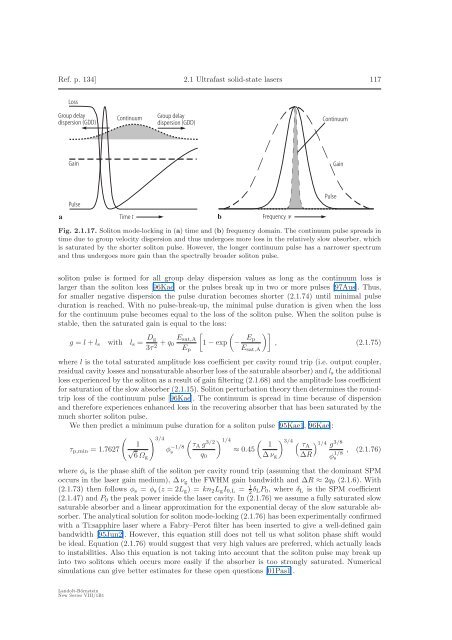2.1 Ultrafast solid-state lasers - ETH - the Keller Group
2.1 Ultrafast solid-state lasers - ETH - the Keller Group
2.1 Ultrafast solid-state lasers - ETH - the Keller Group
You also want an ePaper? Increase the reach of your titles
YUMPU automatically turns print PDFs into web optimized ePapers that Google loves.
Ref. p. 134] <strong>2.1</strong> <strong>Ultrafast</strong> <strong>solid</strong>-<strong>state</strong> <strong>lasers</strong> 117<br />
Loss<br />
<strong>Group</strong> delay<br />
dispersion (GDD)<br />
Continuum<br />
<strong>Group</strong> delay<br />
dispersion (GDD)<br />
Continuum<br />
Gain<br />
Gain<br />
Pulse<br />
Pulse<br />
a<br />
Time t<br />
b<br />
Frequency <br />
Fig. <strong>2.1</strong>.17. Soliton mode-locking in (a) time and (b) frequency domain. The continuum pulse spreads in<br />
time due to group velocity dispersion and thus undergoes more loss in <strong>the</strong> relatively slow absorber, which<br />
is saturated by <strong>the</strong> shorter soliton pulse. However, <strong>the</strong> longer continuum pulse has a narrower spectrum<br />
and thus undergoes more gain than <strong>the</strong> spectrally broader soliton pulse.<br />
soliton pulse is formed for all group delay dispersion values as long as <strong>the</strong> continuum loss is<br />
larger than <strong>the</strong> soliton loss [96Kae] or <strong>the</strong> pulses break up in two or more pulses [97Aus]. Thus,<br />
for smaller negative dispersion <strong>the</strong> pulse duration becomes shorter (<strong>2.1</strong>.74) until minimal pulse<br />
duration is reached. With no pulse-break-up, <strong>the</strong> minimal pulse duration is given when <strong>the</strong> loss<br />
for <strong>the</strong> continuum pulse becomes equal to <strong>the</strong> loss of <strong>the</strong> soliton pulse. When <strong>the</strong> soliton pulse is<br />
stable, <strong>the</strong>n <strong>the</strong> saturated gain is equal to <strong>the</strong> loss:<br />
g = l + l s with l s = D [ (<br />
g<br />
3τ 2 + q E sat,A<br />
0 1 − exp −<br />
E )]<br />
p<br />
, (<strong>2.1</strong>.75)<br />
E p E sat,A<br />
where l is <strong>the</strong> total saturated amplitude loss coefficient per cavity round trip (i.e. output coupler,<br />
residual cavity losses and nonsaturable absorber loss of <strong>the</strong> saturable absorber) and l s <strong>the</strong> additional<br />
loss experienced by <strong>the</strong> soliton as a result of gain filtering (<strong>2.1</strong>.68) and <strong>the</strong> amplitude loss coefficient<br />
for saturation of <strong>the</strong> slow absorber (<strong>2.1</strong>.15). Soliton perturbation <strong>the</strong>ory <strong>the</strong>n determines <strong>the</strong> roundtrip<br />
loss of <strong>the</strong> continuum pulse [96Kae]. The continuum is spread in time because of dispersion<br />
and <strong>the</strong>refore experiences enhanced loss in <strong>the</strong> recovering absorber that has been saturated by <strong>the</strong><br />
much shorter soliton pulse.<br />
We <strong>the</strong>n predict a minimum pulse duration for a soliton pulse [95Kae1, 96Kae]:<br />
( ) 3/4 (<br />
1<br />
τ p,min =1.7627 √ φ −1/8 τA g 3/2 ) 1/4 ( ) 3/4 1 ( τA<br />
) 1/4 g<br />
3/8<br />
s<br />
≈ 0.45<br />
, (<strong>2.1</strong>.76)<br />
6 Ωg q 0 Δ ν g ΔR φ 1/8<br />
s<br />
where φ s is <strong>the</strong> phase shift of <strong>the</strong> soliton per cavity round trip (assuming that <strong>the</strong> dominant SPM<br />
occurs in <strong>the</strong> laser gain medium), Δ ν g <strong>the</strong> FWHM gain bandwidth and ΔR ≈ 2q 0 (<strong>2.1</strong>.6). With<br />
(<strong>2.1</strong>.73) <strong>the</strong>n follows φ s = φ s (z =2L g )=kn 2 L g I 0,L = 1 2 δ LP 0 ,whereδ L is <strong>the</strong> SPM coefficient<br />
(<strong>2.1</strong>.47) and P 0 <strong>the</strong> peak power inside <strong>the</strong> laser cavity. In (<strong>2.1</strong>.76) we assume a fully saturated slow<br />
saturable absorber and a linear approximation for <strong>the</strong> exponential decay of <strong>the</strong> slow saturable absorber.<br />
The analytical solution for soliton mode-locking (<strong>2.1</strong>.76) has been experimentally confirmed<br />
with a Ti:sapphire laser where a Fabry–Perot filter has been inserted to give a well-defined gain<br />
bandwidth [95Jun2]. However, this equation still does not tell us what soliton phase shift would<br />
be ideal. Equation (<strong>2.1</strong>.76) would suggest that very high values are preferred, which actually leads<br />
to instabilities. Also this equation is not taking into account that <strong>the</strong> soliton pulse may break up<br />
into two solitons which occurs more easily if <strong>the</strong> absorber is too strongly saturated. Numerical<br />
simulations can give better estimates for <strong>the</strong>se open questions [01Pas1].<br />
Landolt-Börnstein<br />
New Series VIII/1B1
















